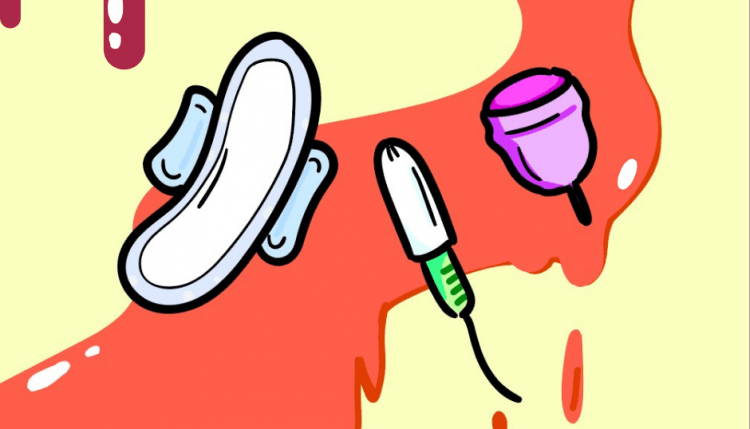
The Hygiene Muck. Part 1
Being a female is tough. PERIOD.
Most females deal with the pain of menstruation each month, needing menstrual products to maintain good hygiene. Between the 4 females in my family, we spend an estimate of US$144 in total on sanitary products each year.
I would be able to afford around 96 bowls of laksa with that same amount…omg
Every time we stock up on more menstrual products, I wonder how much waste we contribute, so I decided to conduct a survey about the sustainability of menstrual products. From the 60 people who took part (55 of which identified as females, and the other 5 identifying as males), US$95 was the average amount spent on menstrual products per year among females. But out of my participants, there were 4 who used reusable pads and menstrual cups that only cost between US$10-15!
That is almost 8 times cheaper than the average mentioned above, and even more so as reusable products last longer. Why then, are people still buying disposable products? 52.6% of participants in the survey said they would not use reusable menstrual products citing reasons like “inconvenience” and “hygiene concerns”.
While the definition of convenience is subjective, I can understand the paranoia that surrounds the cleanliness of reusable menstrual products. However, I think that anxiety applies more to reusable pads rather than menstrual cups. To justify that, I will compare the methods of cleaning between the 4 brands of reusable menstrual products used by those 4 participants.
| Brand | Method of cleaning |
| Organicup | Since they were all the same, I will only list methods from one source.
|
| Divacup | |
| Formoonsa cup | |
| Quinbi (reusable pads) |
|
While Quinbi’s cleaning methods require just water and stain remover, the menstrual cups offer me the extra guarantee of killing off bacteria when boiling it. Thus I would trust it to be more hygienic.
I feel that another reason preventing females from choosing menstrual cups is the cultural and religious stigma of inserting a foreign object into the body. When agrarian societies led to the development of the 3 great monotheistic religions and thus the patriarchy, the concept of a woman’s virtue became increasingly important. A female is expected to keep herself “pure”. Thus I believe that the fear of “losing her virginity” (the loss of which tested by the presence of a hymen) from deeply ingrained patriarchy, hinders many females from choosing a sustainable lifestyle when it comes to feminine hygiene.
Would you look at the mess we’ve gotten ourselves into now…
Being a female is tough indeed. And while we have explored why many females would not use reusable menstrual products, perhaps the environmental impacts of disposable menstrual products in my next post will be able to offer up more insight on how this form of gender expectations have impacted our environment.

jolee2001 September 13, 2020 - 8:49 am
Hi Chloe!
Wow, this post is really relatable! Thank you for bringing this topic up. I’m sure many females have been skeptical of the use of reusable pads or menstrual cups. Do you agree that females who are older tend to be more skeptical of these reusables, while younger females are more accepting of such changes?
– Jo
chloeyong September 14, 2020 - 8:15 am
Hi Jo, thanks for your comment!
I do agree with that statement. I have observed that in my social circles, the only females who use reusable menstrual products are the ones around my age and younger. I also personally think that this is due to increasing education about gender, sex, and the rising awareness of the effects of the patriarchy on female bodies that younger generations receive.
– Chloe 🙂
ENV3102 September 15, 2020 - 10:58 am
Hi Chloe and Jo,
As a woman in her 40s, let me tell you something.
In my 1st yr teaching ENV1101, for the 1st tutorial, when I decided that each year I would undertake a personal action along with my students, this was my action. I switched to a cup.
I had always resisted because I thought it would be gross and messy.
Well, I’ve never looked back. This was by far the best lifestyle change I’ve ever made. It’s WAY cleaner than pads or tampons, I can insert it and not worry about anything for 12 hrs. I understand my period much better. I don’t even notice it. It works out to little to no $$. And there’s nothing going in the garbage.
Interestingly, I’ve noticed more culturally- than age-based reticence. The issues described, i.e., qualms about inserting something, seem much less prevalent in Canada than in SE Asia or the Middle East (in my experience talking with ppl). Most teenage girls in Canada start using tampons right away or soon after their first period, so to us, that’s not the issue.
Anyway, to all the beautiful young women considering this step, please believe me when I say I genuinely wish I’d done this 20 yrs ago when I first heard about these cups. My periods would have been a million times less unpleasant.
Great post by the way.
chloeyong September 15, 2020 - 4:18 pm
Hi Dr. Coleman,
Thanks for your input! I’m excited to say that I will be bringing up a specific example of how culture affects females’ choices in menstrual products, and with it the environmental impacts in my next post:) I’m also considering switching to cups, do you have any brand you would recommend?
– Chloe
ENV3102 September 23, 2020 - 2:18 am
Hi Chloe,
I can’t truly recommend one brand over another cos I started with the most popular one on the global market (Diva) and it was right for me. But I’ve read that many women have to try more than one because we’re all made differently. I think here in SG, it’s not the most popular.
What I did have to experiment with was ways to insert it – so I read blogs and watched youtube vids until I found one that worked for me.
Finally, it might not be easy or comfy the first time you use it. It wasn’t for me. But I’m glad I didn’t give up. By the next day, using it felt totally normal.
good luck !
yalinikmr September 17, 2020 - 4:52 am
Hey Chloe!
When I saw your post, I genuinely got excited that someone was willing to embark on this topic HAHA. So thank you!!
A point of view that I would like to present is that there is also not as much of a reach when it comes to reusable menstrual products. For example, back in India there are entire communities of women who don’t even have the access to or the financial means to buy one-time use pads or tampons. I think this concept of using reusable items is therefore similar to, let’s say, being vegan, your socioeconomic status has a lot to do with how much you can do! Just thought it would be an interesting insight for you hehe 🙂
~ Yalini
chloeyong September 19, 2020 - 3:23 am
Yes Yalini,
I think that is definitely a valid point! It just so happens that the case study I look at for my next post focuses on menstrual hygiene in rural India 🙂
– Chloe